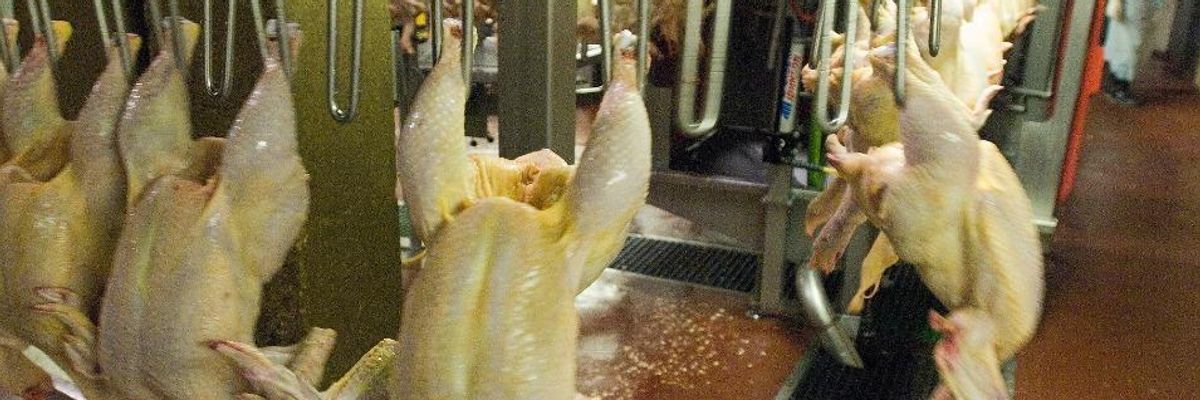

SUBSCRIBE TO OUR FREE NEWSLETTER
Daily news & progressive opinion—funded by the people, not the corporations—delivered straight to your inbox.
5
#000000
#FFFFFF
To donate by check, phone, or other method, see our More Ways to Give page.


Daily news & progressive opinion—funded by the people, not the corporations—delivered straight to your inbox.

A USDA Food Safety Inspection Service (FSIS) inspector at a poultry processing facility in Accomac, Virginia. (Photo: USDA)
The United States Department of Agriculture announced on Thursday new rules for its poultry inspection program that critics fear still leave food and worker safety at risk.
In a statement announcing the overhaul, the USDA says the new system will "prevent thousands of illnesses each year." But under the new rules, some of the inspections that had been done by USDA inspectors will now be done by the companies themselves, a situation critics have called "the fox guarding the hen house."
The Government Accountability Project's Food Integrity Campaign (FIC) is among those who have sounded alarm about the plan.
Alyssa Doom, Investigation & Outreach Coordinator for the FIC, writes that this shifting of inspections to the company
poses a clear conflict of interest. According to inspectors, companies' only goals are to get as much product out their doors as quickly as possible. Retired inspector and USDA whistleblower Phyllis McKelvey spent years working in one of the model's pilot plants and has reported that consumer health will be seriously impacted by this rule. Untrained company workers do not have the power to question their supervisors, which could certainly result in unfit products destined for consumers' plates.
The American Federation of Government Employees (AFGE) National President J. David Cox Sr. similarly admonished the privatization of inspection, issuing a statement that "the loss of independent, government poultry inspectors is a tremendous blow to an inspection system that helps ensure our nation's food safety. "
"With more than 600 people sick from the Foster Farms outbreak alone," added Center for Science in the Public Interest food safety director Caroline Smith DeWaal, "this is hardly the time to reduce USDA's oversight of the poultry industry."
Though the USDA states that "in response to public comment, the maximum line speeds for plants that newly adopt the [New Poultry Inspection System] have remained capped at 140 birds per minute," Food & Water Watch Executive Director Wenonah Hauter says this is not enough.
"This is not a meaningful victory because there are not accompanying worker safety regulations to deal with the musculoskeletal disorders and other work-related injuries that both the plant workers and USDA inspectors suffer every day working in the poultry slaughter plants. In addition, the one USDA inspector left on the slaughter line under this new rule will still have to inspect 2.33 birds every second - an impossible task that leaves consumers at risk," a statement from Hauter reads.
Trump and Musk are on an unconstitutional rampage, aiming for virtually every corner of the federal government. These two right-wing billionaires are targeting nurses, scientists, teachers, daycare providers, judges, veterans, air traffic controllers, and nuclear safety inspectors. No one is safe. The food stamps program, Social Security, Medicare, and Medicaid are next. It’s an unprecedented disaster and a five-alarm fire, but there will be a reckoning. The people did not vote for this. The American people do not want this dystopian hellscape that hides behind claims of “efficiency.” Still, in reality, it is all a giveaway to corporate interests and the libertarian dreams of far-right oligarchs like Musk. Common Dreams is playing a vital role by reporting day and night on this orgy of corruption and greed, as well as what everyday people can do to organize and fight back. As a people-powered nonprofit news outlet, we cover issues the corporate media never will, but we can only continue with our readers’ support. |
The United States Department of Agriculture announced on Thursday new rules for its poultry inspection program that critics fear still leave food and worker safety at risk.
In a statement announcing the overhaul, the USDA says the new system will "prevent thousands of illnesses each year." But under the new rules, some of the inspections that had been done by USDA inspectors will now be done by the companies themselves, a situation critics have called "the fox guarding the hen house."
The Government Accountability Project's Food Integrity Campaign (FIC) is among those who have sounded alarm about the plan.
Alyssa Doom, Investigation & Outreach Coordinator for the FIC, writes that this shifting of inspections to the company
poses a clear conflict of interest. According to inspectors, companies' only goals are to get as much product out their doors as quickly as possible. Retired inspector and USDA whistleblower Phyllis McKelvey spent years working in one of the model's pilot plants and has reported that consumer health will be seriously impacted by this rule. Untrained company workers do not have the power to question their supervisors, which could certainly result in unfit products destined for consumers' plates.
The American Federation of Government Employees (AFGE) National President J. David Cox Sr. similarly admonished the privatization of inspection, issuing a statement that "the loss of independent, government poultry inspectors is a tremendous blow to an inspection system that helps ensure our nation's food safety. "
"With more than 600 people sick from the Foster Farms outbreak alone," added Center for Science in the Public Interest food safety director Caroline Smith DeWaal, "this is hardly the time to reduce USDA's oversight of the poultry industry."
Though the USDA states that "in response to public comment, the maximum line speeds for plants that newly adopt the [New Poultry Inspection System] have remained capped at 140 birds per minute," Food & Water Watch Executive Director Wenonah Hauter says this is not enough.
"This is not a meaningful victory because there are not accompanying worker safety regulations to deal with the musculoskeletal disorders and other work-related injuries that both the plant workers and USDA inspectors suffer every day working in the poultry slaughter plants. In addition, the one USDA inspector left on the slaughter line under this new rule will still have to inspect 2.33 birds every second - an impossible task that leaves consumers at risk," a statement from Hauter reads.
The United States Department of Agriculture announced on Thursday new rules for its poultry inspection program that critics fear still leave food and worker safety at risk.
In a statement announcing the overhaul, the USDA says the new system will "prevent thousands of illnesses each year." But under the new rules, some of the inspections that had been done by USDA inspectors will now be done by the companies themselves, a situation critics have called "the fox guarding the hen house."
The Government Accountability Project's Food Integrity Campaign (FIC) is among those who have sounded alarm about the plan.
Alyssa Doom, Investigation & Outreach Coordinator for the FIC, writes that this shifting of inspections to the company
poses a clear conflict of interest. According to inspectors, companies' only goals are to get as much product out their doors as quickly as possible. Retired inspector and USDA whistleblower Phyllis McKelvey spent years working in one of the model's pilot plants and has reported that consumer health will be seriously impacted by this rule. Untrained company workers do not have the power to question their supervisors, which could certainly result in unfit products destined for consumers' plates.
The American Federation of Government Employees (AFGE) National President J. David Cox Sr. similarly admonished the privatization of inspection, issuing a statement that "the loss of independent, government poultry inspectors is a tremendous blow to an inspection system that helps ensure our nation's food safety. "
"With more than 600 people sick from the Foster Farms outbreak alone," added Center for Science in the Public Interest food safety director Caroline Smith DeWaal, "this is hardly the time to reduce USDA's oversight of the poultry industry."
Though the USDA states that "in response to public comment, the maximum line speeds for plants that newly adopt the [New Poultry Inspection System] have remained capped at 140 birds per minute," Food & Water Watch Executive Director Wenonah Hauter says this is not enough.
"This is not a meaningful victory because there are not accompanying worker safety regulations to deal with the musculoskeletal disorders and other work-related injuries that both the plant workers and USDA inspectors suffer every day working in the poultry slaughter plants. In addition, the one USDA inspector left on the slaughter line under this new rule will still have to inspect 2.33 birds every second - an impossible task that leaves consumers at risk," a statement from Hauter reads.